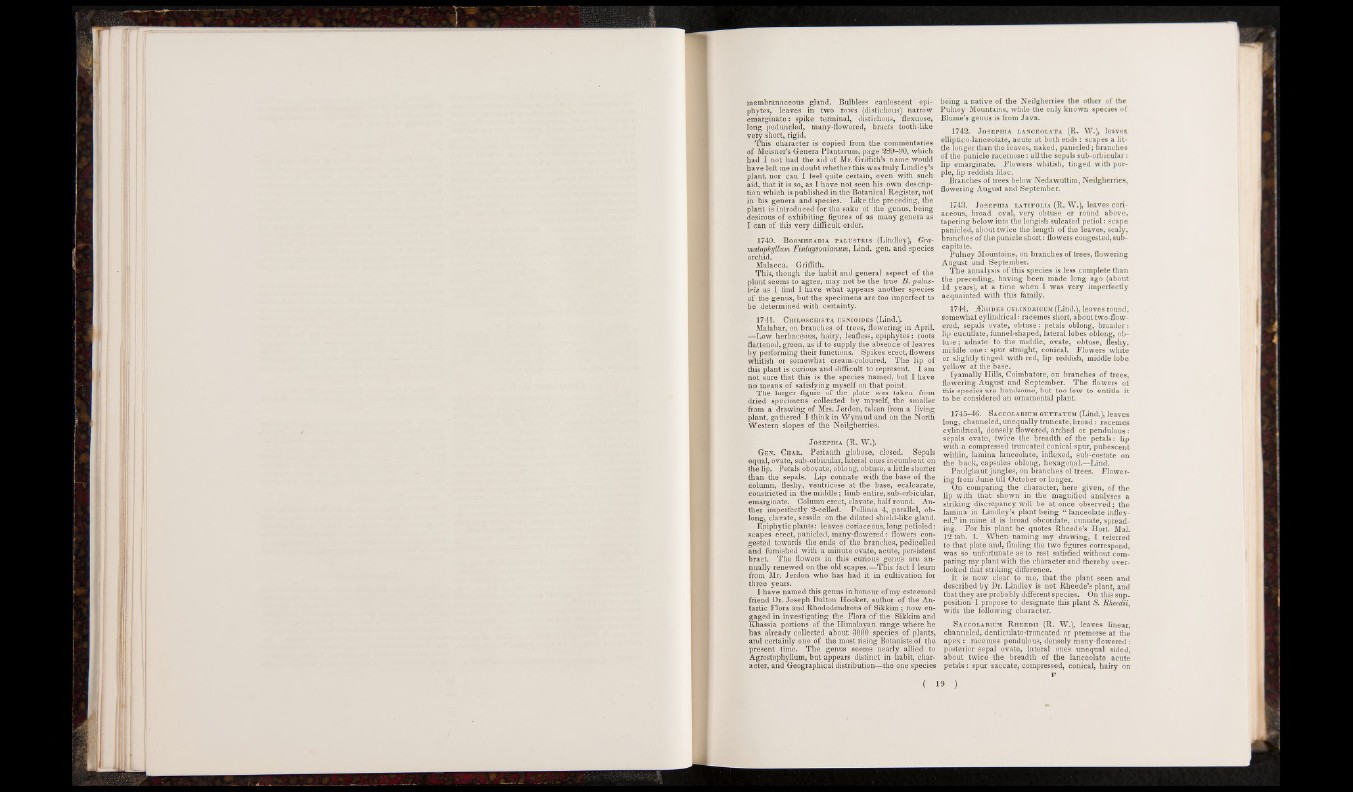
membranaceous gland. Bulbless caulescent epiphytes,
leaves in two rows (distichous) narrow
emarginate: spike terminal, distichous, flexuose,
long peduncled, many-flowered, bracts tooth-like
very short, rigid.
This character is copied from the commentaries
of Meisner’s Genera Plantarum, page 289-90, which
had I not had the aid of Mr. Griffith’s name would
have left me in doubt whether this was truly Lindley’s
plant, nor can I feel quite certain, even with such
aid, that it is so, as I have not seen his own description
which is published in the Botanical Register, not
in his genera and species. Like the preceding, the
plant is introduced for the sake of the genus, being
desirous of exhibiting figures of as many genera as
I can of this very difficult order.
1740. Boomheadia palustris (Lindley), Gra-
matophyllum Finlaysonianum, Lind. gen. and species
orchid.
Malacca. Griffith.
This, though the habit and general aspect of the
plant seems to agree, may not be the true B. palustris
as I find I have what appears another species
of the genus, but the specimens are too imperfect to
be determined with certainty.
1741. . Chiloschista usnioides (Lind;).
Malabar, on branches of trees, flowering in April.
—Low herbaceous, hairy, leafless, epiphytes: roots
flattened, green, as if to supply the absence of leaves
by performing their functions. Spikes erect, flowers
whitish or somewhat cream-coloured. The lip of
this plant is curious and difficult to represent. 1 am
not sure that this is the species named, but I have
no means of satisfying myself on that point.
The larger figure of the plate was taken from
dried specimens collected by myself, the smaller
from a drawing of Mrs. Jerdon, taken from a living
plant, gathered I think in Wynaud and on the North
Western slopes of the Neilgherries.
Josephia (R. W.);
Gen. Char. Perianth globose, closed. Sepals
equal, ovate, sub-orbicular, lateral ones incumbent on
the lip. Petals obovate, oblong, obtuse, a little shorter
than the sepals. Lip connate with the base of the
column, fleshy, ventricose at the base, ecalcarate,
constricted in the m iddle; limb entire, sub-orbicular,
emarginate. Column erect* clavate, half round. Anther
imperfectly 2-celled. Pollinia 4, parallel,- oblong,
clavate, sessile on the dilated shield-like gland.
Epiphytic plants: leaves coriaceous, long petioled :
scapes erect, panicled, many-flowered: flowers congested
towards the ends of the branches, pedicelled
and furnished with a minute ovate, acute, persistent
bract. The flowers in this curious genus are annually
renewed on the old scapes.—This fact I learn
from Mr. Jerdon who has had it in cultivation for
three years.
I have named this genus in honour of my esteemed
friend Dr. Joseph Dalton Hooker, author of the An-
tartic Flora and Rhododendrons of Sikkim ; now engaged
in investigating the Flora of the Sikkim and
Khassia portions of the Himalayan range where he
has already collected about 3000 species of plants,
and certainly one of the most rising Botanists of the
present time. The genus seems nearly allied to
Agrostophyllum, but appears distinct in habit, character,
and Geographical distribution—the one species
being a native of the Neilgherries the other of the
Pulney Mountains, while the only known species of
Blume’s genus is from Java.
1742. J osephia lanceolata (R. W.), leaves,
elliptico-lanceolate, acute at both ends: scapes a little
longer than the leaves, naked, panicled; branches
of the panicle racemose: all the sepals sub-orbicular:
lip emarginate. Flowers whitish, tinged with purple,
lip reddish lilac.
Branches of trees below Nedawuttim, Neilgherries,
flowering August and September.
1743. Josephia la t i folia (R. W.), leaves coriaceous,
broad oval, very obtuse or round above,
tapering below into the longish sulcated petiol: scape
panicled, about twice the length of the leaves, scaly,
branches of the panicle short: flowers congested, sub-
capitate.
Pulney Mountains, on branches of trees, flowering
August and September.
The annalysis of this species is less complete than
the preceding, having been made long ago (about
14 years), at a time when 1 was very imperfectly
acquainted with this family.
1744. B rides cylindricum (Lind.), leaves round,
somewhat cylindrical: racemes short, about two-flowered,
sepals ovate, obtuse: petals oblong, broader:
lip cucullate, funnel-shaped, lateral lobes oblong, obtuse
; adnate to the middle, ovate, obtuse, fleshy,
middle one: spur straight, conical. Flowers white
or slightly tinged with red, lip reddish, middle lobe
yellow at the base.
Iyamally Hills, Coimbatore, on branches of trees,
flowering August and September. The flowers of
this species are handsome, but too few to entitle it
to be considered an ornamental plant.
1745-46. S accolabium guttatum (Lind.), leaves
long, channeled, unequally truncate, broad: racemes
cylindrical, densely flowered, arched or pendulous:
sepals ovate, twice the breadth of the petals: lip
with a compressed truncated conical spur, pubescent
within, lamina lanceolate, indexed, sub-costate on
the back, capsules oblong, hexagonal.—Lind.
Paulghaut jungles, on branches of trees. Flowering
from June till October or longer.
On comparing the character, here given, of the
lip with that shown in the magnified analyses a
striking discrepancy will be at once observed; the
lamina in Lindley’s plant being “ lanceolate indexed,”
in mine it is broad obcordate, cuniate, spreading.
For his plant he quotes Rheede’s Hort. Mai.
12 tab. 1. When naming my drawing, I referred
to that plate and, finding the two figures correspond,
was so unfortunate as to rest satisfied without comparing
my plant with the character and thereby overlooked
that striking difference.
It is now clear to me, that the plant seen and
described by Dr. Lindley is not Rheede’s plant, and
that they are probably different species. On this supposition
I propose to designate this plant S. Rheedii,
with the following character.
S accolabium R heedii (R. W.), leaves linear,
channeled, denticulato-truncated or premorse at the
ap e x : racemes pendulous, densely many-flowered :
posterior sepal ovate, lateral ones unequal sided,
about twice the breadth of the lanceolate acute
petals: spur saccate, compressed, conical, hairy on
p